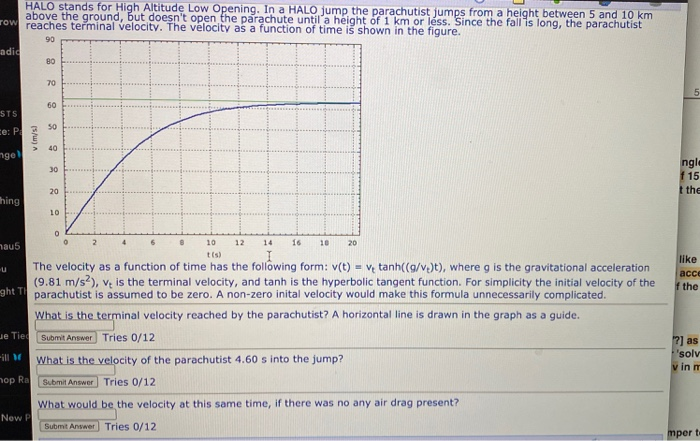Answered step by step
Verified Expert Solution
Question
1 Approved Answer
HALO stands for High Altitude Low Opening. In a HALO jump the parachutist jumps from a height between 5 and 10 km above the

HALO stands for High Altitude Low Opening. In a HALO jump the parachutist jumps from a height between 5 and 10 km above the ground, but doesn't open the parachute until a height of 1 km or less. Since the fall is long, the parachutist row reaches terminal velocity. The velocity as a function of time is shown in the figure. 90 adic thing STS ce: P 50 ngel mau5 -u e Tie ill nop Ra 80 v (m/s) New P 70 60 40 12 14 16 10 20 10 t(s) I The velocity as a function of time has the following form: v(t)= ve tanh((g/ve)t), where g is the gravitational acceleration (9.81 m/s2), ve is the terminal velocity, and tanh is the hyperbolic tangent function. For simplicity the initial velocity of the ght Ti parachutist is assumed to be zero. A non-zero inital velocity would make this formula unnecessarily complicated. What is the terminal velocity reached by the parachutist? A horizontal line is drawn in the graph as a guide. Submit Answer Tries 0/12 What is the velocity of the parachutist 4.60 s into the jump? Submit Answer Tries 0/12 What would be the velocity at this same time, if there was no any air drag present? Submit Answer Tries 0/12 30 20 10 0 0 2 6 5 ngle f 15 t the like acce f the ?] as 'solv v in m mper t HALO stands for High Altitude Low Opening. In a HALO jump the parachutist jumps from a height between 5 and 10 km above the ground, but doesn't open the parachute until a height of 1 km or less. Since the fall is long, the parachutist row reaches terminal velocity. The velocity as a function of time is shown in the figure. 90 adic thing STS ce: P 50 ngel mau5 -u e Tie ill nop Ra 80 v (m/s) New P 70 60 40 12 14 16 10 20 10 t(s) I The velocity as a function of time has the following form: v(t)= ve tanh((g/ve)t), where g is the gravitational acceleration (9.81 m/s2), ve is the terminal velocity, and tanh is the hyperbolic tangent function. For simplicity the initial velocity of the ght Ti parachutist is assumed to be zero. A non-zero inital velocity would make this formula unnecessarily complicated. What is the terminal velocity reached by the parachutist? A horizontal line is drawn in the graph as a guide. Submit Answer Tries 0/12 What is the velocity of the parachutist 4.60 s into the jump? Submit Answer Tries 0/12 What would be the velocity at this same time, if there was no any air drag present? Submit Answer Tries 0/12 30 20 10 0 0 2 6 5 ngle f 15 t the like acce f the ?] as 'solv v in m mper t HALO stands for High Altitude Low Opening. In a HALO jump the parachutist jumps from a height between 5 and 10 km above the ground, but doesn't open the parachute until a height of 1 km or less. Since the fall is long, the parachutist row reaches terminal velocity. The velocity as a function of time is shown in the figure. 90 adic thing STS ce: P 50 ngel mau5 -u e Tie ill nop Ra 80 v (m/s) New P 70 60 40 12 14 16 10 20 10 t(s) I The velocity as a function of time has the following form: v(t)= ve tanh((g/ve)t), where g is the gravitational acceleration (9.81 m/s2), ve is the terminal velocity, and tanh is the hyperbolic tangent function. For simplicity the initial velocity of the ght Ti parachutist is assumed to be zero. A non-zero inital velocity would make this formula unnecessarily complicated. What is the terminal velocity reached by the parachutist? A horizontal line is drawn in the graph as a guide. Submit Answer Tries 0/12 What is the velocity of the parachutist 4.60 s into the jump? Submit Answer Tries 0/12 What would be the velocity at this same time, if there was no any air drag present? Submit Answer Tries 0/12 30 20 10 0 0 2 6 5 ngle f 15 t the like acce f the ?] as 'solv v in m mper t
Step by Step Solution
★★★★★
3.40 Rating (159 Votes )
There are 3 Steps involved in it
Step: 1
a b From the graphe V V tank 2 V ...
Get Instant Access to Expert-Tailored Solutions
See step-by-step solutions with expert insights and AI powered tools for academic success
Step: 2

Step: 3

Ace Your Homework with AI
Get the answers you need in no time with our AI-driven, step-by-step assistance
Get Started


